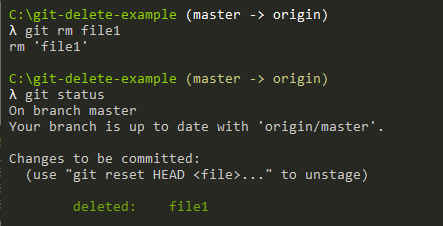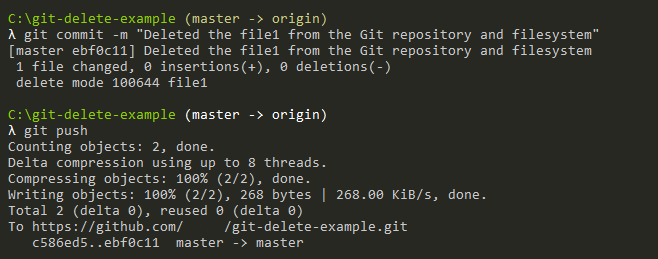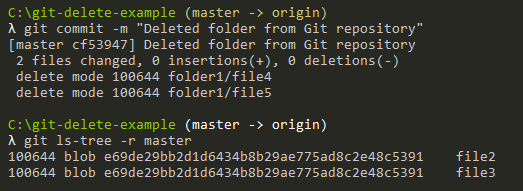When working with Git, it is quite common for developers to add many files to their repository, just to realize that they want to delete them later on.
Deleting files on Git is often a source of confusion : do I need to delete them from my repository or should I delete them from the filesystem?
If you introduced a file in previous commits, is there a way for you to delete this file from all the commits in the repository?
In this tutorial, we are going to see how you can easily delete files on Git, whether it is only from your Git repository or from the filesystem.
Delete Files using git rm
The easiest way to delete a file in your Git repository is to execute the “git rm” command and to specify the file to be deleted.
$ git rm <file>
$ git commit -m "Deleted the file from the git repository"
$ git push
Note that by using the “git rm” command, the file will also be deleted from the filesystem.
Also, you will have to commit your changes, “git rm” does not remove the file from the Git index unless you commit it.
As always, let’s have a quick example in order to illustrate the commands we just described.
In my current repository, I have three files named “file1”, “file2” and “file3” and I want to delete the “file1” file from my Git repository.
By using the “git ls-tree” command, I am able to see the files tracked on my current branch.
$ git ls-tree -r master
In order to delete the file “file1” from the Git repository and from the filesystem, we are going to execute the “git rm” command with the name of the file.
$ git rm file1
rm 'file1'You should get a small confirmation message saying that the “rm” command was executed on this file.

So what happened here?
As you can see, by executing the “git rm” command, a “deleted” action was added to the changes to be committed.
It means that the file was removed from the filesystem but it was not deleted from the index just yet.
In order for the changes to be effective, you will have to commit your changes and push them to your remote repository.

Now the file should be deleted from the filesystem and from the index, you can verify it by re-executing the “git ls-tree” command in order to list files in the current index.

Congratulations, you successfully deleted a file from your Git repository.
Delete Files Recursively on Git
In order to delete files recursively on Git, you have to use the “git rm” command with the “-r” option for recursive and specify the list of files to be deleted.
$ git rm -r <folder>
$ git commit -m "Deleted the folder from the repository"
$ git pushThis is particularly handy when you need to delete an entire directory or a subset of files inside a directory.
As an example, let’s say that our Git repository has a folder named “folder1” that contains two files.
In order to delete this folder, and the files contained in it, we are going to execute the “git rm” command with the “-r” option.
$ git rm -r folder1
Again, do not forget that the changes are effective when you commit them, not before.

Congratulations, you successfully removed an entire folder from your Git repository.
Delete Files From Git Repository only
In some cases, you want to delete files from the Git repository but not from the filesystem, you have to execute the “git rm” command with the “–cached” option.
$ git rm --cached <file>
$ git commit -m "Deleted file from repository only"
$ git pushBack to our example, we currently have two files sitting in our working folder : file2 and file3.
Let’s pretend that we want to delete the file “file2” from the repository but we want to keep it on the filesystem.
To achieve that, we simply execute the “git rm” command with the “–cached” option.
$ git rm --cached file2
As you can see, after executing the “git rm” command, the file is still on the filesystem.
Awesome, you simply have to commit and push the changes now for them to be effective.
What’s in my git status?
Before committing your changes, you may notice with a “git status” command that the file was added to the changes to be committed, as well as in the list of untracked files.

Quite logic because your file is not tracked anymore as the result of your previous deletion.
Now for the file not to be listed in your Git repository under the “untracked files”, make sure to add it to your Git Ignore file.
$ touch .gitignore
# Content of the gitignore file
file2
Commit your gitignore file and you should be good to go!
Delete Files From Git History
In some cases, you want to delete files from your entire Git history.
It may be the case for example if you committed a file that contains passwords or some sensitive information, that you want to remove.
In order to delete file from Git history, you have to use the “git filter-branch” command and specify the command to be executed on all the branches of your Git history.
Finally, you want to specify the revision to execute the changes from : we are going to choose HEAD (as a reminder, HEAD is the last commit of your repository).
In this case, the Git command to be executed is the “git rm” command we described earlier.
$ git filter-branch --force --index-filter --prune-empty "git rm --cached --ignore-unmatch <path_to_file>" HEADAs the command is quite complex, let’s have a breakdown of all the options used :
- –force : quite self-explanatory, it forces the filter-branch to start even if it may not want to (given the documentation because it can contain temporary directories)
- –index-filter : option used in order to rewrite the index, exactly what we want in the case of a file deletion
- “git rm” command : the command to be executed on all branches, revisions and commits matching in the history, in this case it will remove the file from the repository and ignore files that don’t match
- –prune-empty : avoid having empty commits in the repository with zero files, this option will prune commits automatically
In this case, let’s say that we want to delete the file “file1” contained in our repository.
We are going to execute the following command.
$ git filter-branch -f --prune-empty --index-filter "git rm -r --cached --ignore-unmatch ./file1" HEAD
This command can take a while, if your history contains many files, but in the end, the deleted file won’t be in your Git history anymore.
You can check with a “git log” command, but the commits linked to the deleted file should be pruned if necessary.
Conclusion
In this tutorial, you learnt how you can easily delete a file from a Git repository, whether you want to delete it from the filesystem or not.
You also learnt that it is completely possible to delete a file from an entire Git repository using the “filter-branch”.
Deleting files in Git is linked to file restoration, as a consequence, you may be interested with the following resources :
If you are interested in software engineering, we have a complete section dedicated to it on the website, so make sure to check it out.

Icons made by Smashicons from www.flaticon.com


1 comment
After using filter-branch, when i try to commit, push or merge my changes, i recieve this error:
fatal: refusing to merge unrelated histories